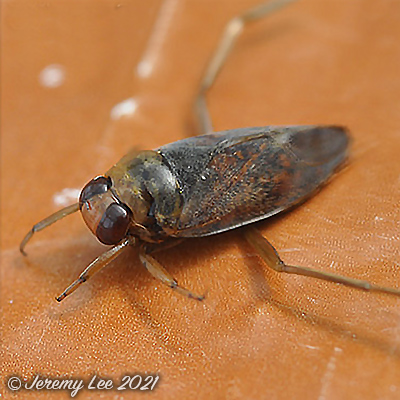
 |
|
Scientific Classifications explained » Amphibians » Ants » Aphids » Bees » Beetles » Birds » Bugs » Butterflies » Caterpillars » Damselflies » Dragonflies » Earwigs » Flies » Frog/Leafhoppers » Fungi » Galls » Grasshoppers » Harvestmen » Hoverflies » Lacewings » Ladybirds » Leaf Mines » Lichens » Mammals » Millipedes » Mosses » Moths » Sawflies » Slugs » Snails » Spiders » Trees » Wasps » Wild Flowers » Woodlice |
UK Nature > Bugs > Notonecta glauca

Scientific Name: Notonecta glauca Common Name: Great Water Boatman Notonecta glauca is up to 18mm long and found throughout the UK. It has a life span of approximately 6 - 9 months and can be seen all year round in ponds, lakes, canals and ditches, surviving on a diet of small insects, fish and tadpoles. Notonecta glauca are true bugs and are light brown in colour with reddish coloured eyes. As the name suggests, the Great Water Boatman swims upside-down, propelling itself through the water with its rear pair of legs which are fringed with tiny hairs. When in motion the rear legs resemble the oars in a rowing boat. Their ventral sides are covered with hairs which trap air and give the insects a silvery appearance in the water. Adults are able to fly. They hunt their prey by floating motionless on the water surface. When they detect movement in the water they swim towards it to see if it is worth catching. The bite from a Great Water Boatman can be painful as their saliva is toxic. They should not be confused with the very similar looking insect called the Lesser Water Boatman (Corixa punctata). The Lesser Water Boatman swims on its front and feeds on algae. |
|

https://www.uknature.co.uk is a website dedicated to showing the immense diversity of UK nature and wildlife. Our vast range of habitats, from lowland arable to snow covered mountains, from storm-ravaged coastlines to peaceful inland freshwater lakes and rivers, from dry, sandy heaths to deciduous and coniferous forests, all these habitats contribute to the abundance of UK nature. We have wild birds in huge numbers either residing or visiting our shores (597 recorded species as at July 2013) and we must also not forget the humble back garden with its grass lawns, flower beds filled with nectar rich flowers, shrubs and trees, all designed to attract huge numbers of insects such as bees, moths, butterflies and hoverflies; and finally the small ponds which provide safe havens for frogs, toads, newts and even slow worms and grass snakes. www.uknature.co.uk is the showcase for my personal passion, photographing uknature in all its glory. I sincerely hope you all enjoy the fruits of my labours. This site and all images contained therein is © Jeremy Lee 2004 - 2021. All Rights Reserved. Site design by Jeremy Lee. Site development & IT Support by Stuart Lee. |